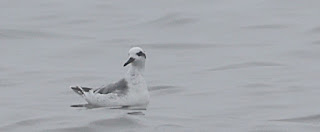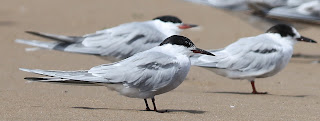Delana had one free day on 29th March, where she didn't have to be tied to the computer. So we arranged for a bird guide to take us Sandwich Harbour. This is a place I had not been before due to the difficult access. Many years ago this spot was a magnet for birds & I had always wanted to visit. However, once our guide Kobus arrived he told me that it hadn't been a prime birding spot for many years due to changing conditions. Oh well, we are going anyway!
Greater Flamingo
Several hundred birds were feeding
in the bay every day.
Lesser Flamingo.
Great White Pelican
Up to 90+ birds were seen each day.
Black-necked Grebe
Beautiful birds in full summer plumage,
but the light was terrible!
This species spends most of the non-breeding season
in salt water,along the coast.
However,it breeds on freshwater lakes & marshes.
Chestnut-banded Plover
This is a highly localised species,
often confined to slt pans.
Walvis Bay is a stronghold for this species.
It is not often one gets close to this species.
Normally they are quite distant
across the pan or bay.
Grey Phalarope
A rarity down here!
Quite exciting to find such a species here
in Namibia!
Even more exciting when we found a second bird
a few kilometres away in the bay!
This is the end of the huge Walvis Bay,
where it meets the sea.
It was time to leave the bay behind
& head up the coast.
It is a mixture of driving along the beach &
slightly inland through the dunes.
Kobus, our guide for the day
with an injured Common Tern.
There we large flocks of Terns along the beach.
Great crested & Common Terns
Sandwich Harbour, from the top
of the highest dune.
It was a little foggy!
It was a nice trip, very enjoyable
but as the guide said, not great for birds.
This really was a tourist trip, with lots of other people around. It was more about crossing the dunes at high speed than anything else. It was nice to have finally visited Sandwich Harbour, but sad to see it in ecological decline. It was a far cry from the old photos I have seen of many thousands of birds congregating here.
The drive back to Walvis.
It is pretty barren out there!
Pelican Point Lighthouse & Hotel.
Cape Fur Seal
The colony is about 80,000 strong!
Black-backed Jackal
I managed to pick out 2 Black Terns
among the throng.
Then a third Black Tern further up the beach!
Black Tern in winter plumage.
This individual had a damaged mandible.
Black Tern is a regular, if uncommon winter visitor to the Namibian coast. The outer part of Walvis Bay is a regular haunt of this species. Very nice to see three birds though! A new species for me in Southern Africa.
Large numbers of Sanderlings were
also on the beach.
It was noticeable that all these birds were
still in full winter plumage.
This is because this species is a late summer arrival
in the high Arctic.
Both Delana & I enjoyed our day tremendously & we can recommend Kobus as a guide. He is a very easy going, who has an excellent knowledge of the natural history of the area. We can definitely recommend him to others.
But now it is time for us to go north to visit our next stop!
Then it was driving back to Walvis Bay to visit Pelican Point, which is the furthest spot one can get to in a vehicle. There is a lighthouse there which has been turned into a very expensive hotel! The prices are crazy for this location. There are lots of beaches for wading birds & roosting Terns,plus a massive Cape Fur Seal colony.
We first went to a couple of spots in the bay, which had restricted access so I had not visited these areas before.

































































No comments:
Post a Comment